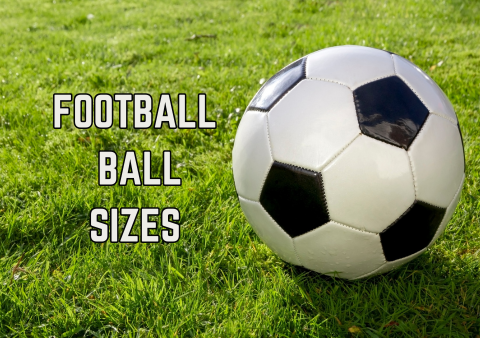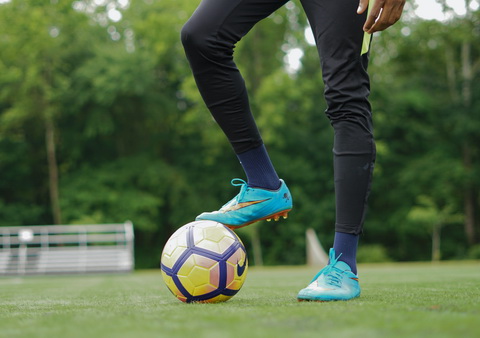In this guide, we’ll talk about football ball sizes and why they’re not all the same. We’ll help you pick the right size football for different ages and skill levels.
If you want to know what size ball the pros use or find the best one for a young player, we’ve got you covered with all the info you need.
Football Ball Sizes Guide
Picking the right size football for a player’s age is important. It helps them learn the game correctly, stay safe, and have fun. If the ball is too big, it’s hard for kids to learn the right moves.
If it’s too small, they won’t be challenged enough as they get older.
Size 1 Ball
Starting with the smallest, size 1 footballs, or mini or skills balls, have a circumference of about 18 to 20 inches.
While not used in standard matches, these balls are excellent tools for skill development, especially regarding footwork and ball control.
They are also popular as souvenirs or for casual play, providing a fun and unique way to engage with the sport.
Size 2 Ball
Size 2 footballs are a bit bigger than the smallest balls, with a size around 20 to 22 inches. They are great for helping players get better at controlling the ball and hitting it accurately.
These balls are not as big as the ones used in games, but they feel more like the real thing than the smallest size. They’re perfect for practice.
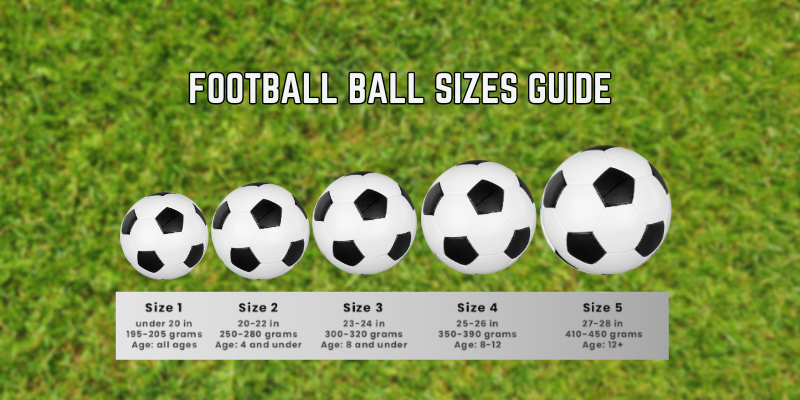
Size 3 Ball
Size 3 footballs, designed for children under 8, have a circumference of about 23 to 24 inches and weigh between 300 to 320 grams.
Their lighter weight makes it easier for young players to kick, carry, and control, which is vital for developing basic skills and building confidence.
Size 4 Ball
For players aged 8 to 12, size 4 footballs are the ideal choice. They measure about 25 to 26 inches in circumference and weigh between 350 to 390 grams.
This slight increase in weight and size from size 3 balls helps bridge the transition to the adult game, offering intermediate players a more challenging yet manageable experience.
Size 5 Balls
Size 5 footballs, the standard for players aged 13 and above, have a circumference of 27 to 28 inches and weigh about 410 to 450 grams.
This weight ensures that the ball moves at a challenging yet fair speed for adult players, providing the right amount of resistance to shots and passes, which is critical for the precision and pace of the professional game.
Understanding Football Ball Official Size
Football ball official size means that the same size ball is used everywhere. Size 5 is the official size for professional and adult games. If you interested more, you can read about the best football countries in the world.
The Importance of Standards
A standard football ball size is important for the game and how well players do. A ball with the right size and weight works best for grown-up players. It lets them control the ball and kick it just right.
When everyone uses footballs that are the same size, players can get better and use their skills in any game, whether it’s a small local match or a big international competition.
Football ball size 5 – the Professional Choice
Professional football players use size 5 balls. These balls are about 27 to 28 inches around and weigh between 410 to 450 grams.
They are made for adults to kick, dribble, and pass well. Size 5 is the standard ball size in pro football games.
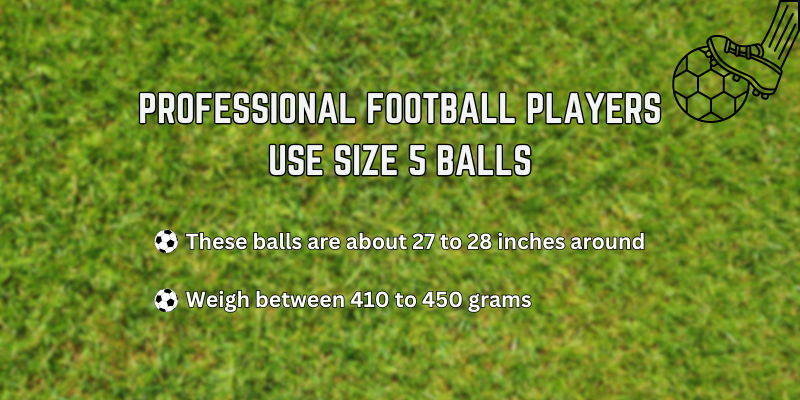
All matches are played with a size 5 ball during the FIFA World Cup.
When watching top teams like Brazil, Germany, or Spain, players like Lionel Messi, Cristiano Ronaldo, and Neymar demonstrate their skills with a ball measuring about 27 to 28 inches in circumference and weighing between 410 to 450 grams.
This size and weight suit the pace, power, and precision required in professional play.
So, if you’re practicing to become a pro player or just want to play with the same type of equipment, using a size 5 ball will give you the most realistic experience.
Why Ball Size in Football Matters?
Ball size in football matters for players. If it’s too big or too small, it can be hard for them to learn and play well.
They might struggle with moving the ball or making good passes and shots. Coaches and players need to know about different football sizes so everyone can play their best.
For instance, consider a youth soccer team with players aged 8 to 10 years. For this age group, a size 4 ball (smaller and lighter than the regulation size 5 ball used in professional adult matches) is recommended.
Let’s say a coach accidentally uses a size 5 ball during practice. The players, still developing their physical strength and ball-handling skills, may struggle with the larger, heavier ball.
They might find it difficult to control the ball, make precise passes, or shoot accurately.
By using the correct size 4 ball, the players could handle the ball more easily, allowing them to focus on improving their technique and understanding of the game.
This would ultimately lead to a more productive practice session and a better overall experience for the young athletes.
Why Ball Weight Matters?
The weight of a football is important because it changes how far it can go when kicked and how it moves in the wind. If a ball is too heavy, it can be hard to kick and might hurt someone.
But if it’s too light, it won’t go where you want it to and can act strangely in the air.
That’s why using the right weight for each ball size is key for a good, safe game. For example, kids playing with a ball meant for adults might struggle to kick it properly because it’s too heavy for them.
Professional Football Ball Size
This means that every player knows what to expect and can play their best in every game, no matter where it is or who they’re playing against.
The Standard in Professional Football
In professional football, the standard ball size is size 5. This ball has a circumference of 27 to 28 inches and weighs between 410 to 450 grams when inflated.
It’s the universal choice in professional leagues worldwide, from the English Premier League to La Liga to the Bundesliga, and is also the size used in international competitions like the FIFA World Cup and UEFA Champions League.
Why Size 5?
Size 5 footballs are made for grown-up players. They are just the right size and weight for playing well, helping players to use their skills and play their best in games.
This size is perfect for good ball control, accurate passes, and shooting well, which are all important in pro soccer.
Regulations and Standards
Professional football has clear rules about how big and heavy the ball should be.
Every ball used in a game is checked to make sure it’s the right size and weight. This is important to keep the game fair and to make sure it’s played the right way.
For instance, a football used in the NFL must weigh between 14 to 15 ounces and be inflated to a pressure between 12.5 to 13.5 pounds per square inch.
Impact on the Game
In pro football, all the balls are the same size. This makes it easy for players to move from one league to another without getting used to a new ball.
This standard helps to fairly judge and grow a player’s talent since their skills work everywhere.
For example, a player can go from playing in Spain to the UK and still play their best because the ball feels the same.
Choosing the Right Football Ball Size by Age
Choosing the right size football isn’t just about how old or skilled you are. It’s important for learning, comfort, and fun. Here’s how to pick the best football size, looking at more than just age and skill level.
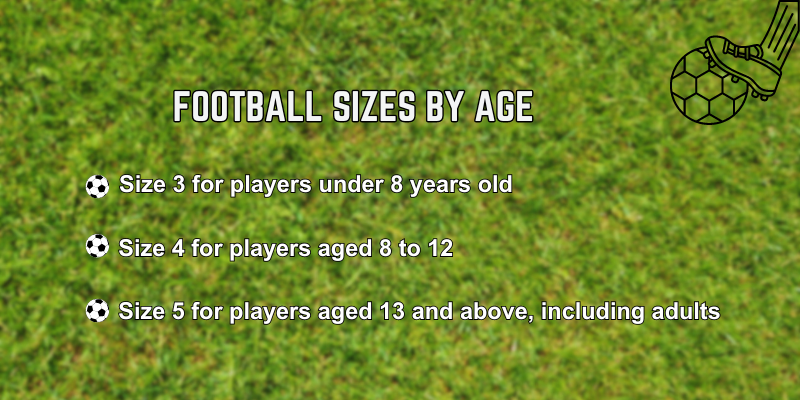
Football Sizes by Age
As previously outlined, football ball sizes are generally determined by age groups. Here’s a quick recap:
- Size 3 for players under 8 years old.
- Size 4 for players aged 8 to 12.
- Size 5 for players aged 13 and above, including adults.
While these age guidelines are a good starting point, they should be considered alongside the player’s size, strength, and skill level.
Skill Level and Training Objectives
Beginners may benefit from initially using a smaller ball size, regardless of their age, to develop basic skills like dribbling and ball control.
More advanced players might use different sizes in training to focus on specific skills. For instance, a size 1 or 2 ball could be used for drills to improve footwork or control.
League and Organizational Requirements
Make sure to look up your league’s rules because they might have special guidelines about what size soccer ball to use.
This is common in leagues for younger players. They do this to keep games fair and consistent.
If you’re a coach or part of a team, it’s really important to follow these rules during practice and games.
Personal Comfort and Preference
Players need to be happy with their ball. It’s good for young players to test out various sizes to find the one that feels best and helps them improve.
Guidelines are helpful, but what feels right for each person is important too, especially just for fun.
Considerations for Purchasing
When purchasing a football, think about where it will be used. Indoor and futsal balls, for instance, can differ in size and design compared to standard outdoor footballs.
Durability and material are also important, especially if the ball will be used on rough surfaces that could lead to wear and tear.
Conclusion
The football ball size is important whether you’re a beginner, a pro, or just playing for fun. We’ve looked at different football sizes, from tiny ones for skill drills to the full-size ones used in adult games.
The right size football helps players get better and have more fun at every level. It’s about comfort and matching the ball to the player’s abilities and where they’re playing.
When choosing a football, consider who will use it and what they need. The perfect choice can really enhance someone’s enjoyment and performance in the game.
FAQ
What size football should I buy for my 8-year-old❓
For an 8-year-old, a size 3 football is recommended. It’s designed for younger players, making it easier for them to handle and control the ball.
Can teenagers use the same size football as professionals❓
✅ Yes, teenagers aged 13 and above should use a size 5 football, which is the same size used by professionals. This size is suitable for their skill level and physical capabilities.
Why are there different sizes of footballs❓
Different sizes are used to accommodate the varying skill levels, ages, and physical strengths of players. Smaller sizes are easier for younger or less experienced players to handle, promoting skill development and enjoyment of the game.
Is it okay to use a smaller football for practice❓
✅ Yes, using a smaller football for practice, like a size 1 or 2, can improve footwork and ball control. However, practicing with the official size you’ll use in games is also important.
How do I know if the football is the right size and weight❓
Check the football’s size number (3, 4, or 5) and its weight, which should be within the standard range for its size. Size 5 should weigh between 410 to 450 grams, size 4 between 350 to 390 grams, and size 3 between 300 to 320 grams.
